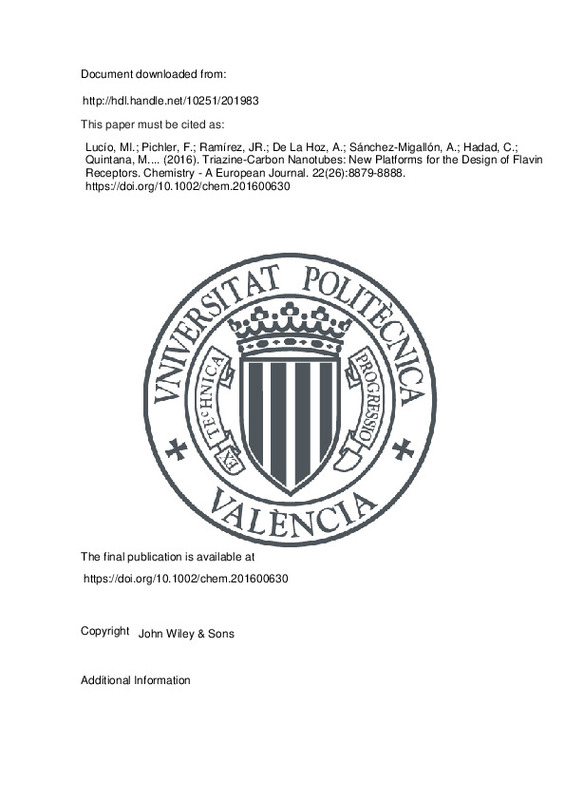JavaScript is disabled for your browser. Some features of this site may not work without it.
Buscar en RiuNet
Listar
Mi cuenta
Estadísticas
Ayuda RiuNet
Admin. UPV
Triazine-Carbon Nanotubes: New Platforms for the Design of Flavin Receptors
Mostrar el registro sencillo del ítem
Ficheros en el ítem
| dc.contributor.author | Lucío, María Isabel
|
es_ES |
| dc.contributor.author | Pichler, Federica
|
es_ES |
| dc.contributor.author | Ramírez, José Ramón
|
es_ES |
| dc.contributor.author | De la Hoz, Antonio
|
es_ES |
| dc.contributor.author | Sánchez-Migallón, Ana
|
es_ES |
| dc.contributor.author | Hadad, Caroline
|
es_ES |
| dc.contributor.author | Quintana, Mildred
|
es_ES |
| dc.contributor.author | Giuliani, Angela
|
es_ES |
| dc.contributor.author | Bracamonte, María Victoria
|
es_ES |
| dc.contributor.author | Fierro, Jose L. G.
|
es_ES |
| dc.contributor.author | Tavagnaco, Claudio
|
es_ES |
| dc.contributor.author | Herrero, Maria Antonia
|
es_ES |
| dc.contributor.author | Prato, Maurizio
|
es_ES |
| dc.contributor.author | Vázquez, Ester
|
es_ES |
| dc.date.accessioned | 2024-01-17T19:02:39Z | |
| dc.date.available | 2024-01-17T19:02:39Z | |
| dc.date.issued | 2016-06-20 | es_ES |
| dc.identifier.issn | 0947-6539 | es_ES |
| dc.identifier.uri | http://hdl.handle.net/10251/201983 | |
| dc.description.abstract | [EN] The synthesis of functionalised carbon nanotubes as receptors for riboflavin (RBF) is reported. Carbon nanotubes, both single-walled and multi-walled, have been functionalised with 1,3,5-triazines and p-tolyl chains by aryl radical addition under microwave irradiation and the derivatives have been fully characterised by using a range of techniques. The interactions between riboflavin and the hybrids were analysed by using fluorescence and UV/Vis spectroscopic techniques. The results show that the attached functional groups minimise the p-p stacking interactions be-tween riboflavin and the nanotube walls. Comparison of p-tolyl groups with the triazine groups shows that the latter have stronger interactions with riboflavin because of the presence of hydrogen bonds. Moreover, the triazine derivatives follow the Stern-Volmer relationship and show a high association constant with riboflavin. In this way, artificial receptors in catalytic processes could be designed through specific control of the interaction between functionalised carbon nanotubes and riboflavin. | es_ES |
| dc.description.sponsorship | M.V.B. undertook this work with the support of the "ICTP TRIL Programme, Trieste, Italy". Financial support from the Spanish MINECO (projects CTQ2011-22410 and CTQ2014-53600-R), the FEDER Project PEII-2014-002A, the University of Castilla-la Mancha, the University of Trieste and the Italian Ministry of Education MIUR (cofin Prot. 2010N3T9M4 and Firb RBAP11ET-KA) is gratefully acknowledged. We also thank Dr. Emilio M. Perez for help with Raman spectroscopy. | es_ES |
| dc.language | Inglés | es_ES |
| dc.publisher | John Wiley & Sons | es_ES |
| dc.relation.ispartof | Chemistry - A European Journal | es_ES |
| dc.rights | Reserva de todos los derechos | es_ES |
| dc.subject | Donor-acceptor systems | es_ES |
| dc.subject | Molecular recognition | es_ES |
| dc.subject | Nanotubes | es_ES |
| dc.subject | Noncovalent interactions | es_ES |
| dc.subject | Receptors | es_ES |
| dc.subject.classification | QUIMICA ANALITICA | es_ES |
| dc.title | Triazine-Carbon Nanotubes: New Platforms for the Design of Flavin Receptors | es_ES |
| dc.type | Artículo | es_ES |
| dc.identifier.doi | 10.1002/chem.201600630 | es_ES |
| dc.relation.projectID | info:eu-repo/grantAgreement/MICINN//CTQ2011-22410/ES/TECNOLOGIAS EMERGENTES. DESARROLLO DE NUEVAS METODOLOGIAS Y APLICACIONES EN QUIMICA DE MATERIALES Y SUPRAMOLECULAR/ | es_ES |
| dc.relation.projectID | info:eu-repo/grantAgreement/MINECO//CTQ2014-53600-R/ES/MATERIALES BASADOS EN GRAFENO COMO SISTEMAS PROGRAMABLES MULTI-ESTIMULO-RESPUESTA PARA LA LIBERACION CONTROLADA DE FARMACOS/ | es_ES |
| dc.relation.projectID | info:eu-repo/grantAgreement/EC//PEII-2014-002A/ | es_ES |
| dc.relation.projectID | info:eu-repo/grantAgreement/MIUR//2010N3T9M4/ | es_ES |
| dc.relation.projectID | info:eu-repo/grantAgreement/MIUR//Firb RBAP11ET-KA/ | es_ES |
| dc.rights.accessRights | Abierto | es_ES |
| dc.contributor.affiliation | Universitat Politècnica de València. Escuela Técnica Superior de Ingeniería Agronómica y del Medio Natural - Escola Tècnica Superior d'Enginyeria Agronòmica i del Medi Natural | es_ES |
| dc.description.bibliographicCitation | Lucío, MI.; Pichler, F.; Ramírez, JR.; De La Hoz, A.; Sánchez-Migallón, A.; Hadad, C.; Quintana, M.... (2016). Triazine-Carbon Nanotubes: New Platforms for the Design of Flavin Receptors. Chemistry - A European Journal. 22(26):8879-8888. https://doi.org/10.1002/chem.201600630 | es_ES |
| dc.description.accrualMethod | S | es_ES |
| dc.relation.publisherversion | https://doi.org/10.1002/chem.201600630 | es_ES |
| dc.description.upvformatpinicio | 8879 | es_ES |
| dc.description.upvformatpfin | 8888 | es_ES |
| dc.type.version | info:eu-repo/semantics/publishedVersion | es_ES |
| dc.description.volume | 22 | es_ES |
| dc.description.issue | 26 | es_ES |
| dc.identifier.pmid | 27168484 | es_ES |
| dc.relation.pasarela | S\369683 | es_ES |
| dc.contributor.funder | European Commission | es_ES |
| dc.contributor.funder | Universidad de Castilla-La Mancha | es_ES |
| dc.contributor.funder | European Regional Development Fund | es_ES |
| dc.contributor.funder | Ministerio de Ciencia e Innovación | es_ES |
| dc.contributor.funder | Ministerio de Economía y Competitividad | es_ES |
| dc.contributor.funder | Ministero dell'Istruzione, dell'Università e della Ricerca | es_ES |







![[Cerrado]](/themes/UPV/images/candado.png)

